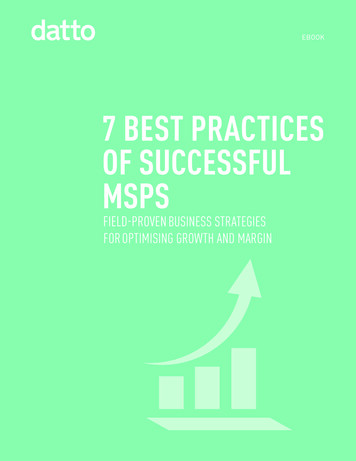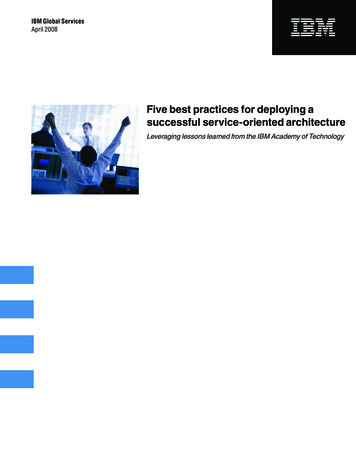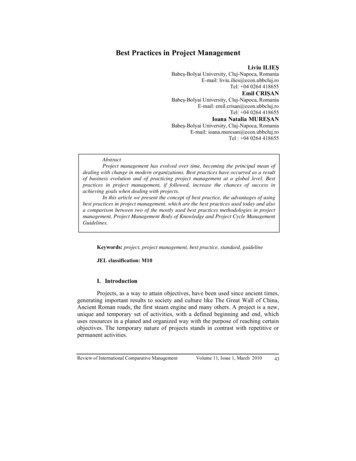
Transcription
EBOOK7 BEST PRACTICESOF SUCCESSFULMSPSBUSINESS STRATEGIESFOR OPTIMISING GROWTH AND MARGIN
ContentsIntroduction.3Effective MSP habit #1.4Define and document repeatable processes.4Effective MSP habit #2 .5Be missional .5Effective MSP habit #3.6Choose and maintain a technical offering focus . 6Effective MSP habit #4.7Build recurring revenue.7Effective MSP habit #5.8Cultivate high-percentage entry points .8Effective MSP habit #6.10Build a better talent pipeline .10Recruit for potential .10Nurture and motivate .10Long-term retention .10Effective MSP habit #7.11Pick the right partners .112 EBOOK: 7 Best Practices of Successful MSPs
IntroductionThe managed services provider (MSP) market is growing. Revenues havebeen estimated to exceed 128 billion in 2019—a CAGR of 12.5%.1 Thepercentage of companies making use of MSPs has also been estimated ashaving grown from around 30% to 50% in the last year alone.2But these are just the macro numbers. Growth for individual MSPs variesconsiderably. A significant portion of MSPs have seen their businesses grow by20% or more annually. About half, however, are only growing at about 10% orless.3Just as importantly, operating margins also vary considerably among MSPs.High-growth MSPs often find that their profits don’t keep pace with theirrevenue, because they are not achieving adequate efficiencies of scale. Othersare growing their top lines more slowly, but are achieving much better bottomline results.This ebook offers seven strategic tips for MSPs looking to optimise growthand profits in the coming years. It is based on research culled from multiplesources including analysts, trade associations, and Datto’s first-handexperience with our own highly diverse MSP community. By adopting thesestrategies, MSP leaders can make the most of current macro market growth—and out-perform the numerous competitors this growing market continues toattract.1MarketandMarkets, Managed Service Global Forecast, January 20152CompTIA, Annual Trends in Managed Services, May 20153Kaseya, MSP Pricing Survey, October 2014datto.co.uk 3
SUCCESSFUL MSP PRACTICE #1:Define and document repeatable processesTechnical competency is necessary for MSP success, but it’s not sufficient. Toprofitably deliver economically valuable technical services at scale, MSPs mustalso make that delivery consistently repeatable.This repeatability can present a challenge to MSP leaders, who are oftenhands-on technical practitioners themselves—and who have thus developedtheir own processes and methods that are as idiosyncratic as they areeffective. These leaders thus tend to expect their staff to apply similarcompetency and creativity to their jobs, in the hope that this competency andcreativity will make the business a success.Unfortunately, if everybody does everything differently, some of them will doit wrong. Some of them will also take more time to do it, which invalidatespricing. And some of them will do it right—and quickly—but will do it in a waythat confuses the customer.When it comes to an MSPsdesire to grow, establishinghabitual processes andprocedures is crucial.Neglecting this first stepmakes the following habitsdifficult to achieve andmaintain.Inadequately defined and documented processes also make MSPs vulnerableto staff turnover, since a new hire can’t quickly replicate the behavior ofsomeone who just left.MSP leaders therefore need to build repeatability into all aspects of thebusiness, including both technical operations and customer engagement.More specifically MSPs must: Rigorously document all repeated business processes with flowchartsthat include actions, decision-points, scripts, etc. Build a work culture that promotes and rewards process discipline, whilealso empowering people to deviate from process when circumstancesmake it appropriate to do so. Implement metrics (task time, response time, number of customercontacts, etc.) to monitor process performance and consistency. Institutionalise process improvements by capturing, codifying, andrewarding them.The third bullet above—process measurement—can be particularlyproblematic for MSP leaders who like to get things done without spending toomuch time considering how they get done. But investment in process metricsis essential to scale MSP operations while maintaining quality and profitability,even as different people perform different tasks.MSP leaders should also consider process outcomes above and beyondefficiency and immediate process outcomes. ITIL processes, for example, mayadd steps to problem resolution in the short term—but they have a broaderimpact on quality and customer satisfaction in the long term. So processdiscipline isn’t just about getting things done quickly and effectively. It’s alsoabout aligning actions with an MSP’s “Big Picture” business strategy.4 EBOOK: 7 Best Practices of Successful MSPs
When it comes to an MSPs desire to grow, establishing habitual processesand procedures is crucial. Neglecting this first step makes the followinghabits difficult to achieve and maintain.Key takeaways: Investments in process capture and codification pay multipledividends. It’s hard to continuously improve a business you’re not continuouslymeasuring. Well-defined processes mitigate the downside of staff turnover.SUCCESSFUL MSP PRACTICE #2:Be missionalHowever they define it, highperformance MSPs almostuniversally connect theirbusiness model to a missionor vision.It takes a lot of work to be a successful MSP. You have to put together greattechnology solutions, win over customers who can easily spend their moneyelsewhere, diligently deliver the responsive service it takes to keep thosecustomers once you get them, continuously coach a growing team of diversepersonalities, and rigorously control costs.All that daily “blocking and tackling” can get to you, even if you’re makingmoney—because, face it, there’s lots of ways to make money in IT. So you mayneed more than just a profit motive to lead your company to MSP excellence.You also need a mission.Market-leading MSPs define their mission in various ways. Some defineit as bringing technology excellence to their local market. Others definetheir mission as empowering a particular vertical to reap the benefits of aparticular set of technologies.However they define it, high-performance MSPs almost universally connecttheir business model to a mission or vision. By doing so, they reap a variety ofbenefits: Mission elevates brand. Any MSP can walk into a customer’s office andoffer to do a decent job at a reasonable price. Not every MSP can offerpartnership with a technology service provider on a mission—especially ifthat mission aligns well with the prospect’s own business objectives. Mission energises culture. People perform better when they’re workingfor more than just a paycheck. This is especially true of technically skilledMillennials, who have lots of employment options. Mission can contributesignificantly to the kind of workplace culture required to attract, motivate,and retain these vital team members.datto.com 5
Mission drives direction. Without mission, MSP leaders can struggle todecide where to expand their business next. Do you try to guess whatthe Next Big Thing will be? Do you just passively allow each successivecustomer to randomly lead the business this way and that? Mission helpsMSPs avoid these common pitfalls so they stay on a clear growth track.The bottom line: If you haven’t yet articulated a clear mission for your MSPpractice, do so. And if you think you kinda sorta know what it is, clarify it andmake it more central to everything you do and communicate. That’s whatmakes leaders leaders—and it’s one of the most important ingredients in theirrecipe for business success.Key takeaways: To be a leader, you have to know where you’re going. Passion and purpose have a positive impact on customers andemployees. Having a mission isn’t enough. You also have to communicateit—clearly and often.An MSP’s focus should be onmaking their offerings thebest of the best.SUCCESSFUL MSP PRACTICE #3:Choose and maintain a technical offering focusMany MSP leaders are pretty sure just about any business could benefit fromtheir skills and knowledge. And they may be right. Servers, after all, areservers. And it’s a rare SaaS implementation that poses any especially difficulttechnical challenge to a skilled MSP.But trying to be all things to all people is a recipe for disaster. When it comesto choosing which verticals to cater to, that tends to be geographically decidedupon (an MSP in Washington D.C. will most likely have a government client ortwo). An MSP’s focus should be on making their offerings the best of the best.For example, some MSPs may work at offering the strongest networkmaintenance to the various industries surrounding them.Once MSPs have become masters of their technology they can apply it to manyverticals. Truly understanding the technology they are selling is key. Beinga master of products will help to answer those tough questions customersmight have about functionality, support, and IT management as a whole.That’s why successful MSPs tend to zero in on one or more very specifictechnical niches. These niches will help them become to go-to MSP in theirarea.Regardless of which particular niches an MSP targets, the resulting upsidescan be significant. A clear focus:6 EBOOK: 7 Best Practices of Successful MSPs
Supports creation of a competitively differentiated brand identity. Enables efficient, effective marketing activities such as participation intrade associations with highly qualified membership. Increases credibility with prospects based on referenceable successesfrom companies with similar needs. Facilitates accurate pricing and service-level guarantees based onprevious engagements. Increases operating margins through implementation of replicablesolutions. Turns every engagement into a high-value learning experience that canenhance the value provided to every other customer.For these reasons and others, MSPs should be wary of offering a broad menuof products and services and instead develop strong technical offerings incertain areas.Key takeaways: Jacks of all trades are masters of none.Being a master of productswill help to answerthose tough questionscustomers might have aboutfunctionality, support, and ITmanagement as a whole. A clear focus increases marketing efficiency and effectiveness. Doing similar things for similar customers leads to higher qualityand bigger margins.SUCCESSFUL MSP PRACTICE #4:Build recurring revenueMSP leaders often spent a good part of their careers working as a VAR and/orin the systems integration business, where revenue often comes in large butsporadic doses. Transitioning to a recurring-revenue MSP model can be toughfor these people, since monthly services income can feel more like a tricklethan a fire hose—and it can create pretty painful cash-flow challenges.But the market is changing. SaaS and other cloud services offer customersa low-capex approach to technology implementation. In fact, the sharingeconomy more generally is enabling companies to reduce capital investmentsin everything from office space to delivery vehicles. So it’s important for MSPsto capitalise on this trend, rather than fighting it.Here are some tips for making the recurring-revenue model work: Re-think all IT as a service. Customers don’t want to get boggeddown in the ownership of servers, networks, disk arrays, databases,software, websites, authentication systems, or even end-userdatto.co.uk 7
devices. Instead, they want to gain specific business capabilities thatincidentally require these underlying components. So figure out waysyou can provide customers with capabilities on a pay-to-play basis.Data, application logic, and actionable analytics are ultimately whatmake the world go around—not ownership of CPUs or flash drives.Perhaps the most importantprinciple to bear in mind isthat a recurring-revenuemodel forces an MSP tofocus more rigorously oncustomer satisfaction,since revenue and profitsultimately depend onretention and renewals. Price for fully bundled value. Previous business models split pricinginto two silos: marked-up capital goods (typically low-margin) andhourly itemised services (typically high-margin). A recurring revenuemodel requires eliminating the traditional notions of both markup anditemised services. Instead, equipment and labor costs are opaque tothe customer—while pricing is based on total value tothe customer, rather than a markup on total cost. Profitability thusdepends on maximising value to the customer while controlling costs.Undifferentiated services simply won’t support a profitable pricepoint. Re-structure you own cash flow. Because MSPs tend not to receivelarge infusions of capital, they have to be increasingly creative abouttheir own cash flow. This is why successful MSPs often turn to cloudservices themselves to support their business. It’s also why they oftentake advantage of the sharing economy for capabilities that they oncemight have built in-house—including financials, marketing, and QA.Perhaps the most important principle to bear in mind is that a recurringrevenue model forces an MSP to focus more rigorously on customersatisfaction, since revenue and profits ultimately depend on retention andrenewals. MSPs that don’t structure their services and staff incentives tosupport customer satisfaction will thus wind up having to constantly chasenew customers—which is not nearly as lucrative as keeping existing ones.Key takeaways: Differentiated convenience and ease support premium price-points. Reliable, long-term income requires a rigorous focus on customersatisfaction. Rigorous cash-flow management is essential to stay in the game.SUCCESSFUL MSP PRACTICE #5:Cultivate high-percentage entry pointsMSP success is contingent upon building stable recurring revenue over time.Top MSPs place a lot of emphasis on the concept of “building.” That’s becausefew customers are inclined to jump into a large, all-inclusive contract with anew IT partner right away. MSPs therefore need a strategy that enables them8 EBOOK: 7 Best Practices of Successful MSPs
to first establish trust—and then incrementally expand account penetrationover time.Some MSPs take what they consider to be an opportunistic approach toaccount entry by simply trying to land whatever initial engagement a newcustomer will accept. This approach, however, can turn out to be more randomthan opportunistic, since not all of these engagements lend themselves toincremental expansion.A more intentional—and more effective—strategy for account entry differsfrom this kind of opportunistic/random approach in two ways:An expansion plan forexisting accounts cancontribute at least as muchto business growth asprospecting for new ones. It intentionally limits scope and/or scale. Successful MSPs havediscovered that it often doesn’t pay to grab too much of a customer’sbusiness on the first pass. For one thing, an over-sized initialengagement can lead to big, early mistakes that undermine trust.A more limited scope enables both the MSP and the customer towork out any kinks in the engagement—whether those kinks involveprocess, pricing, or politics—without a lot of downside risk. Foranother, MSPs gain credibility with customers by not appearing toogreedy at the outset. It intentionally maps out phased account penetration. Smart MSPsare not only intentional about where they start with accounts. Theyare also intentional about how they expand account penetration. Forexample, a data protection/business continuity engagement may startwith just a few core applications plus email and then expand over timeto include unstructured data and personal workspaces. Or a mobilityengagement may start with mobile device management (MDM)and then expand to include mobile help desk and wireless expensemanagement (WEM). Moreover, many MSPs explicitly map out thiskind of phased expansion in advance with the customer. This plannedexpansion helps drive sales growth while adding value by guidingcustomers’ IT environments to a target/desired state in a disciplined,phased manner.In other words, starting small tends to be better for the long-termrelationship. And an expansion plan for existing accounts can contribute atleast as much to business growth as prospecting for new ones.Key takeaways: Avoid short-term greed. Talk openly with customers about possible growth scenarios for theengagement. Leverage account intelligence to drive incremental sales.datto.co.uk 9
SUCCESSFUL MSP PRACTICE #6:Build a better talent pipelineEvery service business is a people business. So when MSPs stop growing, itis more often than not because they don’t have enough of the right people todeliver more services to more customers.Most MSP leaders recognise this intuitively. But they nonetheless struggle todevelop the kind of talent pipeline necessary to keep expanding their business.Many go as far as to blame the labor market, rather than any shortcomings intheir own talent management strategy.Successful MSPs, in stark contrast, take responsibility for building the kind ofteam it takes to keep getting better and bigger. These MSPs focus on the threefundamentals of HR:Recruit for potentialMSPs must also recognizethat they are competingfor talent—and thatattracting talent requiresmore than just competitivecompensation. Highpotential recruits also needto be offered an opportunityto grow and be part of anattractive workplace.Immediate pressures often drive MSP leaders to make hiring decisions basedalmost exclusively on present technical skills. This is a mistake. Skills can belearned. So while new hires should be able to demonstrate proficiency in theircurrent areas of interest, their long-term value to the business has more to dowith their ability to grow professionally over time. New hires should thereforealso be selected based on their ability to learn new skills as required and—perhaps even more importantly—understand the MSP business model and thecustomer demands that drive it.MSPs must also recognise that they are competing for talent—and thatattracting talent requires more than just competitive compensation. Highpotential recruits also need to be offered an opportunity to grow and be part ofan attractive workplace. So MSP leaders need to think about what they can doto make it more exciting for an IT professional to become part of the team.Nurture and motivateBuilding a great team requires more than just hiring great people. In fact,hiring is just the start. Talent has to be developed and nurtured over time,too. And that takes more than just a pat on the back and the occasionalperformance bonus. That’s why MSP leaders need to craft a complete strategyfor talent development that includes continuing education and incentivesfor taking on additional responsibilities. MSP leaders may also want toconsider job rotations that expose staff to alternative career paths in technicaloperations, sales, marketing, and business operations.10 EBOOK: 7 Best Practices of Successful MSPs
Long-term retentionMSP leaders that invest in the education and development of their staff oftenbemoan the fact that other companies can wind up benefitting from thoseinvestments. But people will inevitably leave a company if they don’t feelvalued and aren’t incentivised to stay. Customers notice this turnover—andare usually not that happy about it. MSPs should therefore take reasonablesteps to keep their best people on board.MSP leaders should also recognise that when they hire someone new, they’reprobably benefitting from the investment that person’s previous employermade in someone who ultimately left their company. In a free labor market, noMSP’s talent pipeline is an entirely closed system—so everyone benefits whenemployers invest in their people.Key takeaways: Businesses can only grow if their people do too. Technical competency alone is not sufficient for competitivedifferentiation.MSPs need to keep servicedelivery as simple aspossible. To do that, ithelps to limit the number of“moving parts” that need tobe integrated. Talent development requires intentional, systematic efforts.SUCCESSFUL MSP PRACTICE #7:Pick the right partnersChannel players have always had to choose their partners wisely. But thecriteria MSPs apply to their technology partners differ from that of VARs andSIs in some significant ways.Resellers, for example, are typically focused on attributes such as technicalspecs, brand power, and discount structure. That’s because they had to closepurchase deals with customers who knew what kind of hardware and softwarethey were getting.MSPs are in a much different position. They are delivering services and tryingto optimise customer satisfaction over time. So customers have less visibilityinto how MSPs deliver value—while MSPs have to be more concerned with thequality and efficiency of an ongoing engagement.Key criteria for MSP partners therefore include: Solid technology. Technical excellence is still important to MSPs.But reliability and simplicity can be more important than traditional“speeds and feeds.” That’s because MSPs need to avoid downtime andglitches that undermine customer satisfaction. They also need to avoiddatto.com 11
implementation and integration chaos that can eat into profit margins. Ease of use. Ease of use has always been a desirable productattribute, but it has become much more so now that MSP operatingmargins depend on it. MSPs should therefore look for partnersproviding solutions that are clearly designed to be as intuitive andself-configuring as possible. Responsive support. Responsive technical support has also alwaysbeen important to channel players. But the customer satisfactionimperatives MSPs face make it especially important that they can getfast answers on a 24x7x365 basis. The typical outsourced/offshoredsupport model rarely cuts it when service to a customer is activelycompromised. In fact, it may even make sense to work with a partnerwho can support the customer directly where appropriate. Service-aligned cost structures. MSPs have to be very careful aboutthe cost structure they build into their service offerings. Cloudbased service providers that charge for every unit of utilization, forexample, can put MSPs in the uncomfortable position of having to askcustomers for too much extra money following an unanticipated spikein business activity. A better approach is one that accommodates suchspikes in the interest of long-term account retention. Reporting and metrics. Because MSPs take full responsibilityfor service outcomes, they often require substantial insight intoavailability, utilization, and other aspects of the technical environment.They may also have to provide a variety of reports and dashboards totheir customers. The right vendor partner should be able to providethis kind of reporting. Solution completeness. MSPs need to keep service delivery assimple as possible. To do that, it helps to limit the number of “movingparts” that need to be integrated. It also helps to not have to managean excessive number of vendor relationships or create excessivelycomplex cost structures. Partners that deliver complete solutions canhelp MSPs achieve all of these objectives.Key takeaways: MSPs need cost models that support their business model. Convenience and support can be as important to MSPs as theyare to MSP customers. The MSP model makes the MSP’s brand more important thanthe partner’s.12 EBOOK: Seven Habits of Highly Effective MSPs
About DattoDatto provides business continuity solutions to secure the essential business datafor thousands of companies around the world. Our integrated suite of servicesinclude our market leading data backup and disaster recovery (BDR) offerings,our advanced Cloud-to-Cloud (C2C) backup services for leading SaaS applications,and our innovative network continuity solutions. All delivered as managed servicesprimarily through Managed Service Providers (MSPs) for the data protection needsof small and midsized businesses or distributed locations of large enterprises.For more information, visit www.datto.co.uk.EMEA Headquarters250 Longwater AvenueRG2 6GBpartners@datto.comwww.datto.coRegional OfficesNorwalk, CTBoston, MAToronto, CANReading, UK88 294 631280 571 4984877 811 0577 44 (0) 118 402 9606 2017 Datto, Inc. All rights reserved.
For example, some MSPs may work at offering the strongest network maintenance to the various industries surrounding them. Once MSPs have become masters of their technology they can apply it to many verticals. Truly understanding the technology they are selling is key. Being a master of products will help to answer those tough questions customers











